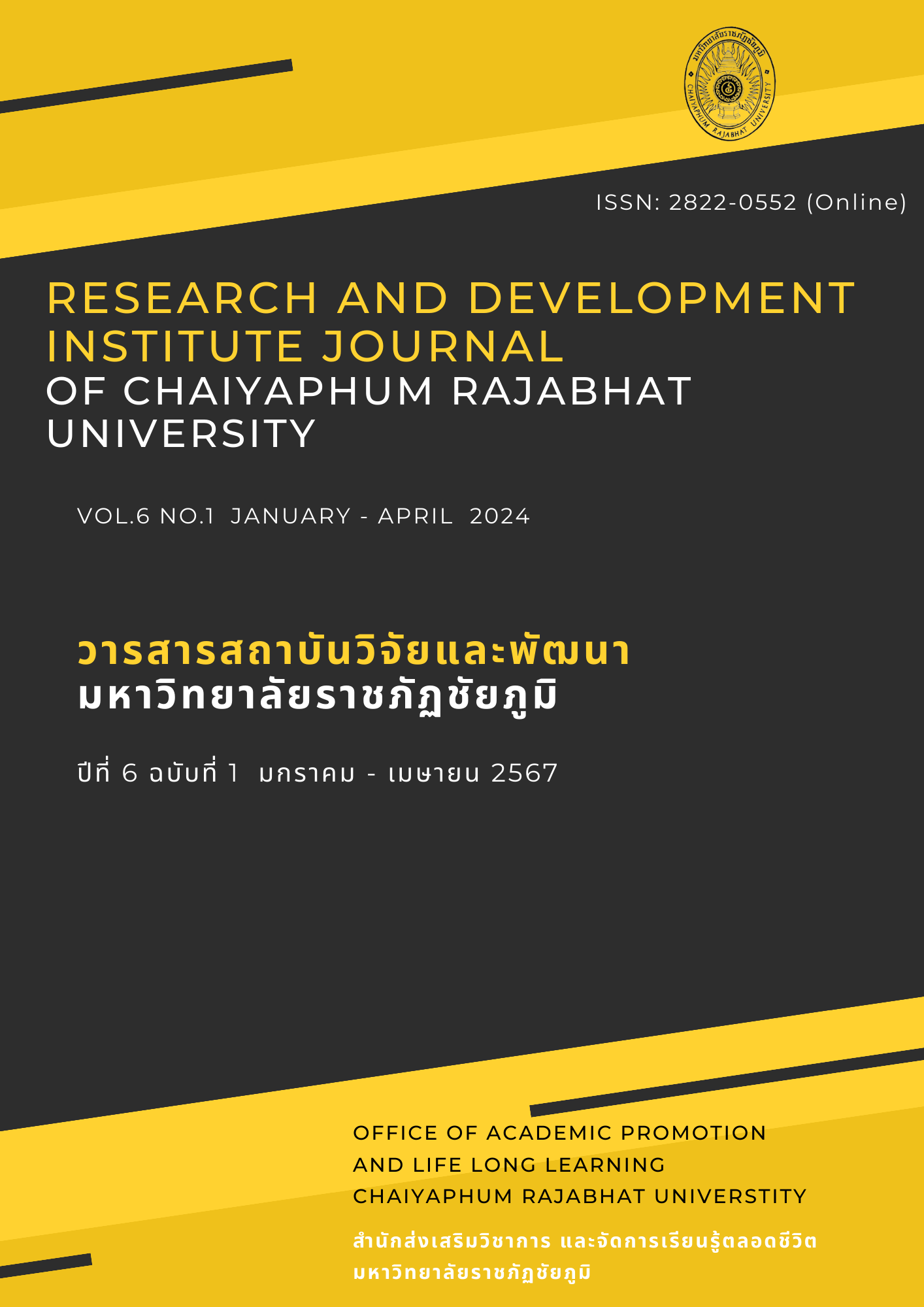Fostering Students' Critical Thinking and Modeling Skills in Grade 6 Based on Inquiry-Based Learning and Model-Based Learning
Main Article Content
Abstract
The objective of the research was to compare the effects of pre-class and post-class fostering of critical thinking and modeling skills on Grade 6 students who managed to learn based on inquiry-based learning and model-based learning. The target group for the study was 14 students in Grade 6, which was obtained from a purposive sampling from the classrooms taught by the researcher in the second semester of the academic year 2021 at Charusornbumrung School, Pathum Thani Province. The instruments used to collect data include: 1) lesson plans based on inquiry-based learning and model-based learning about the fossil story; 2) critical thinking skills tests; and 3) modeling skills tests. The statistics used to analyze the data include percentage, mean, standard deviation, and test the hypothesis by a statistical T-test for dependent samples.
After organizing learning around inquiry-based learning and model-based learning, the test results indicated the following: 1) post-class, students exhibited significantly higher mean scores in critical thinking skills compared to pre-class, with a statistical significance level of 0.01, and 2) post-class, students displayed significantly higher mean scores in modeling skills compared to pre-class, with statistical significance at the 0.01 level, aligning with the hypothesis.
Article Details

This work is licensed under a Creative Commons Attribution-NonCommercial-NoDerivatives 4.0 International License.
Permission to use text, content, images, etc. of publication. Any user to read, download, copy, distribute, print, search, or link to the full texts of articles, crawl them for indexing, pass them as data to software, or use them for any other lawful purpose. But do not use it for commercial use or with the intent to benefit any business. Published under a Creative Commons Attribution-NonCommercial-NoDerivatives 4.0 International License.

This work is licensed under a Creative Commons Attribution-NonCommercial-NoDerivatives 4.0 International License
References
กระทรวงศึกษาธิการ. (2560). หลักสูตรแกนกลางการศึกษาขั้นพื้นฐาน พ.ศ. 2551 (ปรับปรุง พ.ศ. 2560). กระทรวงศึกษาธิการ. https://academic.obec.go.th/images/document/1559878925_d_1.pdf
บุญชม ศรีสะอาด. (2541). การพัฒนาการสอน (พิมพ์ครั้งที่ 2). สุวีริยาสาส์น.
บุญชม ศรีสะอาด. (2551). การวิจัยเบื้องต้น (พิมพ์ครั้งที่ 7). สุวีริยาสาส์น.
พิมพ์พันธ์ เตชะคุปต์. (2544). การเรียนการสอนที่เน้นผู้เรียนเป็นสำคัญ: แนวคิด วิธี และเทคนิคการสอน. เดอะมาสเตอร์กรุ๊ฟแมนเนจเม้นท์.
สถาบันส่งเสริมการสอนวิทยาศาสตร์และเทคโนโลยี. (2555). คู่มือการจัดการเรียนรู้กลุ่มสาระวิทยาศาสตร์. สถาบันส่งเสริมการสอนวิทยาศาสตร์และเทคโนโลยี.
สถาบันส่งเสริมการสอนวิทยาศาสตร์และเทคโนโลยี. (2564). ผลการประเมินการอ่าน คณิตศาสตร์ และวิทยาศาสตร์ PISA 2018. สถาบันส่งเสริมการสอนวิทยาศาสตร์และเทคโนโลยี (สสวท).
Akinyemi Omotayo, S., & Oluwatoyin Adeleke, J. (2017). The 5e instructional model: a constructivist approach for enhancing students’ learning outcomes in mathematics. JISTE, 21(2). https://files.eric.ed.gov/fulltext/EJ1176946.pdf
Bhattacharjee, J. (2015). Constructivist Approach to Learning– An Effective Approach of Teaching Learning. International Research Journal of Interdisciplinary & Multidisciplinary Studies (IRJIMS), 1(6), 65–74.
Clement, P. (2007). Introducing the Cell Concept with both Animal and Plant Cells: A Historical and Didactic Approach. Science and Education, 16, 423–440.
Duran, L. B., & Duran, E. (2004). The 5E Instructional Model: A Learning Cycle Approach for Inquiry-Based Science Teaching. The Science Education Review, 3(2). https://files.eric.ed.gov/fulltext/EJ1058007.pdf
Jadeerat, P., Prasitpong, S., & Vanichanon, A. (2021). The Development of Analytical Thinking Skill of 10th Grade Students by Using Inquiry Approach with Questioning Techniques. Journal of Education, Prince of Songkla University, Pattani Campus, 32(1), 61–75. https://so02.tci-thaijo.org/index.php/edupsu/article/view/234266
Krause, R., von Mering, C., & Bork, P. (2003). A comprehensive set of protein complexes in yeast: Mining large scale protein-protein interaction screens. Bioinformatics, 19(15), 1901–1908. https://doi.org/10.1093/bioinformatics/btg344
Kuatthai, N., & Chookhampaeng, S. (2020). Development Modelling Ability of Grade 10 Students in Biology Using Model-based Learning. Sisaket Rajabhat University Journal, 12(2), 63–71. https://so05.tci-thaijo.org/index.php/sskrujournal/article/view/246510
Maison, M., Darmaji, D., & Kurniawan, D. A. (2019). Science process skills and motivation. Humanities and Social Sciences Reviews, 7(5), 48–56. https://doi.org/10.18510/hssr.2019.756
Phettaweeporndech, K., Kerdtham, C., Sriharun, B., & Kongthong, U. (2015). Science Instruction Model Critical Thinking Upper Secondary School Students. NakhonPhanomUniversityJournal, 5(2), 24–32. https://so03.tci-thaijo.org/index.php/npuj/article/view/43885
Phueaksakun, P. (2018). Using model-based learning and film to Support Grade 8 Syudents’ Analytical Thinking in Global Change. Naresuan University.
Richardson, L. (2000). Writing: A method of inquiry. In N. K. Denzin & Y. S. Lincoln (Eds.), Handbook of qualitative research (2nd ed., pp. 923–947). Sage Publications.
Rodriguez, S., Allen, K., Harron, J., & Qadri, S. A. (2019). Making and the 5E Learning Cycle. The Science Teacher, 086(05). https://doi.org/10.2505/4/tst18_086_05_48
Rosenblueth, A., & Wiener, N. (1945). The Role of Models in Science. Philosophy of Science, 12(4), 316–321. http://www.jstor.org/stable/184253
Schwarz, C. V., Reiser, B. J., Davis, E. A., Kenyon, L., Achér, A., Fortus, D., Shwartz, Y., Hug, B., & Krajcik, J. (2009). Developing a learning progression for scientific modeling: Making scientific modeling accessible and meaningful for learners. Journal of Research in Science Teaching, 46(6), 632–654. https://doi.org/10.1002/tea.20311
Taylor, P. C. (2014). Constructivism. In Encyclopedia of Science Education. Springer Netherlands. https://doi.org/10.1007/978-94-007-6165-0_102-2
Taylor, P. C., Fraser, B. J., & Fisher, D. L. (1997). Monitoring constructivist classroom learning environments. International Journal of Educational Research, 27(4), 293–302. https://doi.org/10.1016/S0883-0355(97)90011-2
Thanjai, T., Suttiwan, W., & Pinthong, T. (2021). Using the scientific models to promote analytical thinking ability and learning achievement of the solar system of grade 9th students. Journal of Humanities and Social Science Valaya Alongkorn, 16(1), 31–47. https://so06.tci-thaijo.org/index.php/vrurdihsjournal/article/view/246869
Tobin, K., & Tippins, D. (1993). Constructivism as a referent for teaching and learning. In K. Tobin (Ed.), The practice of constructivism in science education (pp. 3–21). AAAS Press.
Treagust, D., & Chittleborough, G. D. (2009). Why Models are Advantageous to Learning Science. Educación Química, 20(1). https://doi.org/10.1016/S0187-893X(18)30003-X
Tupsai, J., Yuenyong, C., & Taylor, P. C. (2015). Initial implementation of constructivist physics teaching in Thailand: A case of bass pre-service teacher. Mediterranean Journal of Social Sciences, 6(2), 506–513. https://doi.org/10.5901/mjss.2015.v6n2p506


